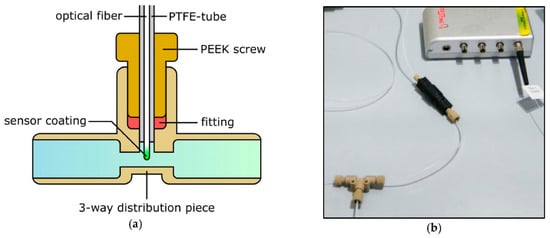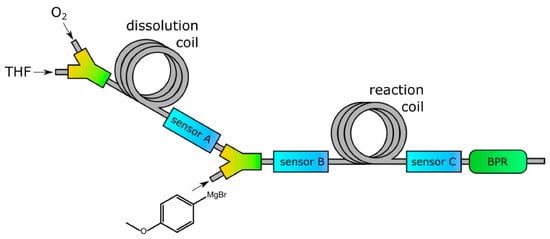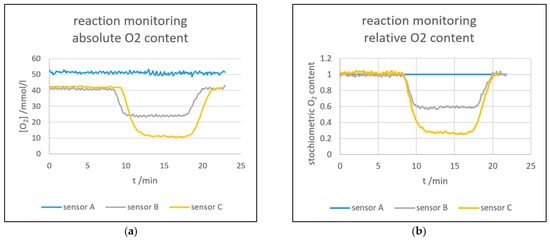Abstract
In this contribution we present an optical oxygen sensor that can easily be integrated into continuous flow reactors. The sensors are pressure resistant to up to 8 bars and are able to continuously measure oxygen for several hours in organic solvents. The dynamic range was evaluated up to 42 mmol/L O2 and several calibrations showed the sensors to perform linearly according to Stern-Volmer, which allows convenient two-point calibrations. By using state-of-the-art HPLC connectors and materials the sensor can be implemented at virtually every point of a standard flow reactor. Readout is conducted via a 4-channel USB phase fluorimeter.
1. Introduction
Fiber sensors allow measurements in reaction environments that would be challenging to analyze with other classical sensor approaches []. Whereas they pose advantages like remote measurements, miniaturization and low response times, their application can be limited by environmental conditions. The use of highly permeable polymers as sensor matrices often limit online oxygen measurements in flow reactors to aqueous systems and atmospheric oxygen conditions []. We present an optical fiber sensor for oxygen that can be used in organic solvents and at concentrations significantly above the solubility at standard pressure. The aim is to continuously monitor the oxygen content at different places of the reactor during an oxygen consuming reaction. An already published and optimized Grignard reaction was used as a test model to demonstrate the potential of the sensors for online measurements.
2. Materials and Methods
2.1. Sensor Preparation and Integration
The sensor fiber (WFGe 400/440 T obtained by Ceramoptec) is decladded and the tip is sharpened by flame-cutting and grinding. The sensor coating, containing the NIR emitting phosphorescent sensor dye [] is carefully applied onto the tip. A fitting PTFE-tube is pushed over the fiber by which the sensor can be equipped with a PEEK HPLC screw and fitting. The fiber can be positioned exactly within the flow-through channel by sliding it within the tube before screwing the sensor tight (Figure 1).

Figure 1.
(a) Schematic visualization of the sensor implementation via standard HPLC equipment; (b) photograph of the sensor integrated into a continuous flow system. On the upper right corner the miniaturized phase fluorimeter used for readout can be seen.
2.2. Sensor Response
To gain information about the sensor response several sensors were calibrated at varying oxygen concentrations (Figure 2). The oxygen concentrations were controlled by mixing it via a Mass Flow Controller into a constant stream of solvent. To achieve the desired elevated oxygen concentrations, the system pressure had to be kept at around 8 bar to increase oxygen solubility.

Figure 2.
Reactor scheme of the sensor calibration step including Y-piece, dissolution coil, sensor and back pressure regulator.
After ensuring the linearity of the calibration according to Stern-Volmer, further measurements within the system were conducted only after two-point calibrations at 0 and 42 mmol/L O2.
2.3. Monitoring of Oxygen Consumption
To undergo a practical test of our sensors we used a reaction that was already investigated in the scope of continuous flow by Jamison et al. A selective oxidation of 4-Methoxyphenylmagnesium bromide was conducted with subsequent trapping in HCl to form the corresponding phenole (Figure 3).

Figure 3.
Selective oxidation of 4-Methoxyphenylmagnesium bromide.
The reactor was assembled similarly to the calibration system with an oxygen dissolution compartment and a sensor to record the initial O2 concentration before the reaction (Figure 4). A second Y-mixer is used to introduce the Grignard reagent into the system. Two more sensors are introduced into the system before and after a reaction coil, that provides reaction volume. A back pressure regulator keeps the reactor environment at 8 bar system pressure.

Figure 4.
Scheme of the reaction setup including reagent inlet and two additional sensors before and after a reaction coil.
3. Results
3.1. Sensor Calibration
The calibrations showed varying absolute values in phosphorescence lifetime, indicating aggregation effects of the sensor dye in the matrix. The calibration curve τ0/τ vs. [O2] however show a linearity for all three sensors (Figure 5). These results led to the decision to prepare further measurements by using only two-point calibrations.

Figure 5.
(a) recorded oxygen content during a multi-step calibration with four oxygen concentrations (0, 21, 31.5, 42 mmol/L O2); (b) Stern-Volmer plot of all three sensors showing the linearity of the calibrations despite diverging absolute lifetime values.
3.2. Reaction Monitoring
The introduction of Grignard reaction showed a constant and reproducible oxygen consumption within the reactor (Figure 6). Besides being able to record oxygen consumption during the reaction, it was also possible to identify the moment of the first product to arrive at the reactor outlet.

Figure 6.
(a) absolute values of O2 measurements before, during and after the Grignard reaction; (b) dividing the oxygen concentrations by the sensor A control value (correcting the time delay and dilution factor) lead to stoichiometric oxygen consumption at different points of the reactor.
4. Discussion
The presented measurements show the applicability of our system at conditions that are unusually harsh for optical sensors (organic solvents at 8 bar system pressure). It was shown that the sensor can be initialized by quick two-point calibrations within the reactor itself. Further experiments will be conducted by using additional sensors within the reaction space and changing system parameters like pressure, temperature and flow rates. This may lead to improved and quicker reaction control and optimization for novel oxidation reactions.
Acknowledgments
This research was financed by the Austrian Research Promotion Agency (FFG), in the framework COMET program project “Center for Continuous Flow Synthesis & Processing”, CCFLOW (project No. 862766). The financial support is greatly acknowledged.
References
- Chu, C.; Lo, Y.; Sung, T. Review on Recent Developments of Fluorescent Oxygen and Carbon Dioxide Optical Fiber Sensors. Photonic Sens. 2011, 1, 234–250. [Google Scholar] [CrossRef]
- Pedersen, A.T.; de Carvalho, T.M.; Sutherland, E.; Rehn, G.; Ashe, R.; Woodley, J.M. Biotechnol. Bioeng. 2017, 114, 1222–1230. [CrossRef] [PubMed]
- Koren, K.; Borisov, S.M.; Klimant, I. Stable optical oxygen sensing materials based on click-coupling of fluorinated platinum(II) and palladium(II) porphyrins—A convenient way to eliminate dye migration and leaching. Sens. Actuators B Chem. 2012, 169, 173–181. [Google Scholar] [CrossRef] [PubMed]
Publisher’s Note: MDPI stays neutral with regard to jurisdictional claims in published maps and institutional affiliations. |
© 2019 by the authors. Licensee MDPI, Basel, Switzerland. This article is an open access article distributed under the terms and conditions of the Creative Commons Attribution (CC BY) license (https://creativecommons.org/licenses/by/4.0/).